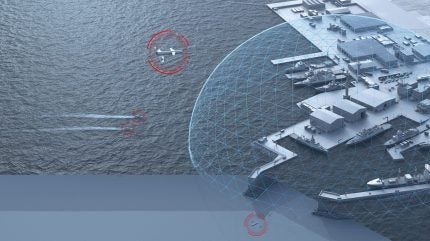
MARSS has delivered its layered protective network – encompassing various sensors and effectors – to two major naval bases in the Middle East according to a company statement on 19 February 2025.
The concept was announced during the International Defence Exhibition and Conference (IDEX 2025) in Abu Dhabi, United Arab Emirates.

Discover B2B Marketing That Performs
Combine business intelligence and editorial excellence to reach engaged professionals across 36 leading media platforms.
Known as NiDAR, the system-of-systems creates a “protective dome” over the two stationary sites. Although, the concept is agile enough to protect an expeditionary force on the move, all centralised from a compact, containerised command and control station.
Through artificial intelligence-driven real-time data fusion, the concept allows operators to detect, track, classify, and respond to potential threats faster. The suite covers air, surface, and underwater threats, ensuring situational awareness and rapid response while ensuring little cognitvie overload to the human in the loop.
Since MARSS last showcased NiDAR at DSEI in September 2023, the concept has evolved to include uncrewed autonomous vehicles of all kinds. This was proven during a US Combat Capabilities Development Command trial – integrating many of the market’s assets – in August 2024.
A new threat landscape
There are new technologies emerging that pose a formidable threat to stratgeic targets as seen by the tit-for-tat missile exchange between Iran and Israel last year to Russia’s brutal invasion of Ukraine. Uncrewed systems of all types appear to be playing a role at the centre of modern operations on account of their affordability and versatile engagement with the adversary.

US Tariffs are shifting - will you react or anticipate?
Don’t let policy changes catch you off guard. Stay proactive with real-time data and expert analysis.
By GlobalDataAccording to GlobalData’s strategic intelligence report, ‘Drones in Aerospace and Defense’ (2025), GlobalData estimates that the global drone market was worth $15.2bn in 2020 and will reach $89.6bn by 2030, with the strongest growth coming from commercial sector, which will record a compound annual growth rate of 32.6% in this decade, rising from $3.4bn in 2020 to $57bn in 2030.
“Protective Dome”
At IDEX, Rob Balloch – MARSS’ chief growth officer – spoke to Naval Technology about the use of the dome in the Middle East, saying “the [Gulf Co-operation Council] nations are pushing harder and harder into integration.”
The company currently has three clients in the region.
Rhetoric in the defence community has played on the word ‘dome’ in recent months, with US President Donald Trump applying the word in a call for an “Iron Dome for America”, loosely based on the Israeli-style air defence network.
Balloch similarly touched on the rise of protective domes of this kind, expecting “nation shields” to emerge by 2030; “the technology is already there” he emphasised.



